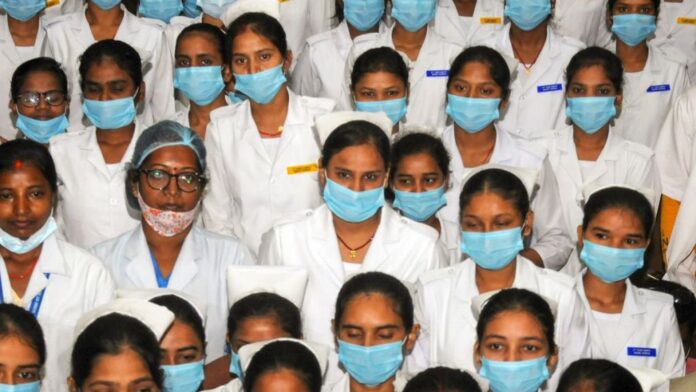Qalam Times News Network
New Delhi, May 31:
India has seen a notable resurgence in COVID-19 activity over the past few days, with the number of active cases climbing steadily and now crossing the 3,000-mark. According to data released by the Union Ministry of Health and Family Welfare, the country currently has 3,395 active COVID-19 cases. This increase coincides with the confirmation of four COVID-linked deaths reported in the last 24 hours, one each from Delhi, Kerala, Karnataka, and Uttar Pradesh.The rise, though modest when compared to previous waves, has triggered a renewed focus among health authorities and experts, especially given the simultaneous emergence of new subvariants of the virus.
Gradual Increase in Active Cases Over the Week
The active caseload in India has more than tripled within a week. On May 22, the country had 257 known active infections. By May 26, that number had reached 1,010, and in just five days, it has spiked to 3,395 as of the latest count. The Health Ministry confirmed that 685 new cases were registered in the last 24 hours alone.
While the numbers remain significantly lower than during the peak waves of the pandemic, this sudden increase has prompted central and state governments to reassess local surveillance strategies and healthcare preparedness, especially in states showing early signs of a case spike.
State-wise Breakdown of Active Cases
As per the official data, Kerala is currently the worst-affected state, accounting for nearly 39% of all active infections nationwide, with 1,336 ongoing cases. Following Kerala is Maharashtra with 467 cases, while Delhi is managing 375 active patients. Other states with relatively high counts include Gujarat (265), Karnataka (234), West Bengal (205), Tamil Nadu (185), and Uttar Pradesh (117).
Health departments in these states have intensified testing, tracing, and community monitoring efforts to prevent further escalation. Authorities in Kerala and Maharashtra have also urged citizens to voluntarily wear masks in crowded places and to seek early medical attention in case of flu-like symptoms.
Details of the Reported Fatalities
The Health Ministry’s report noted that the four fatalities recorded in the past 24 hours occurred in elderly or medically vulnerable individuals, many of whom were already suffering from multiple health complications.
• In Delhi, a 71-year-old man passed away after being diagnosed with pneumonia and septic shock, compounded by acute kidney injury. His pre-existing conditions made recovery difficult despite medical intervention.
• Karnataka reported the death of a 63-year-old man, also suffering from pneumonia and septic complications, along with other chronic ailments.
• In Kerala, a 59-year-old male patient lost his life after battling Type-II respiratory failure and sepsis. His condition had deteriorated rapidly despite being under intensive care.
• Uttar Pradesh reported the youngest casualty — a 23-year-old man who died while undergoing treatment at AIIMS Rishikesh. He reportedly had underlying health issues, though specific details remain confidential.
These fatalities serve as a stark reminder that while the virus may have weakened in severity, it continues to pose a threat, especially to individuals with co-morbidities and the elderly.
Variant Surveillance and Virological Updates
As cases began to climb, virologists and public health officials intensified genome sequencing of viral samples from affected regions. According to Dr. Rajiv Bahl, Director General of the Indian Council of Medical Research (ICMR), current infections are primarily being driven by subvariants of the Omicron lineage, which are generally associated with milder illness but higher transmissibility.
Four specific subvariants have been identified in the samples analyzed so far: LF.7, XFG, JN.1, and NB.1.8.1, with the first three being the most prevalent. These variants have been circulating in various parts of southern and western India.
Dr. Bahl emphasized that none of the identified variants show evidence of causing severe illness or immune escape at a level that would overwhelm the healthcare system. “We’re observing increased case numbers, yes, but the clinical severity remains very low,” he said. “Most patients are recovering at home with only mild to moderate symptoms.”
Health Authorities Urge Caution, Not Panic
Senior officials from the Union Health Ministry have reassured the public that the situation remains manageable and that there is no cause for alarm. The majority of the new cases are being treated at home, with a minimal number requiring hospitalization. Hospitals and medical facilities remain well-equipped to handle any potential surge, should it occur.
“People should not panic. We are monitoring the situation very closely. There is no exponential rise in hospital admissions, which is a good sign,” a health ministry spokesperson said. “We urge citizens to continue observing basic precautions — hand hygiene, mask usage in crowded places, and prompt reporting of symptoms.”
The Ministry is also in close coordination with state health departments, advising them to increase testing in clusters where multiple cases are emerging. Sentinel surveillance is being strengthened, especially in airports and transit hubs, to track any possible entry of new variants from abroad.
The Road Ahead: Vigilance Is Key
While the current wave appears to be under control, public health experts continue to advocate for vigilance and preventive behavior, particularly for high-risk populations. Seasonal changes, increased travel, and public gatherings could contribute to further transmission if precautions are not followed.
India’s COVID-19 vaccination coverage remains high, with most eligible adults having received both primary doses and booster shots. However, health officials are reminding those who are immunocompromised or elderly to consider getting additional booster doses as recommended by their physicians.
Looking ahead, experts believe that COVID-19 is likely to remain an endemic virus, with periodic spikes driven by emerging variants or changes in public behavior. The key, they say, lies in balanced public communication, continued scientific surveillance, and community-level awareness.
In conclusion, while the country is not facing a crisis, the recent uptick serves as a timely reminder that the pandemic is not fully behind us. The virus, though weakened, still demands respect — and a responsible public response.
______________
All data sourced from the Union Health Ministry and Indian Council of Medical Research (ICMR).







